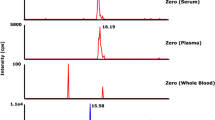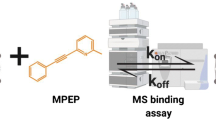Abstract
We herein present the first LC-MS/MS quantification method for indatraline, a highly potent nonselective inhibitor of the three monoamine transporters (for dopamine, DAT; norepinephrine, NET; serotonin, SERT), and its application to MS Binding Assays. For HPLC, an R18 column with a mobile phase composed of acetonitrile and ammonium bicarbonate buffer (5 mmol L-1, pH 10.0) in a ratio of 90:10 (v/v) at a flow rate of 600 μL min-1 was used. Recording indatraline at m/z 292.2/261.0 and (2H7)-indatraline, employed as internal standard, at m/z 299.2/268.0 allowed reliable quantification from 5 pmol L−1 (LLOQ) to 5 nmol L−1 in biological matrices without additional sample preparation. Validation of the developed quantification method showed that selectivity, calibration standard curve, accuracy, as well as precision meet the criteria of the CDER guideline. Applying this method to mass spectrometry (MS) Binding Assays, a label-free MS-based alternative to conventional radioligand binding assays, binding of indatraline’s eutomer, (1R,3S)-indatraline, towards NET could be characterized directly for the first time, revealing an equilibrium dissociation constant (K d) of 805 pmol L−1. Additionally, it could be shown that the established MS Binding Assays enable characterization of test compounds in competition experiments. As the established setup is based on a 96-well format and an LC MS/MS method with a short chromatographic cycle time (1.5 min), the developed MS Binding Assays enable considerable throughput and are therefore well suited as substitute for corresponding radioligand binding assays.







Similar content being viewed by others
References
Schildkraut JJ, Kety SS (1967) Biogenic amines and emotion. Science 156(3771):21–37
Lapin IP, Oxenkrug GF (1969) Intensification of the central serotoninergic processes as a possible determinant of the thymoleptic effect. Lancet 1(7586):132–136
Skolnick P, Popik P, Janowsky A, Beer B, Lippa AS (2003) “Broad spectrum” antidepressants: is more better for the treatment of depression? Life Sci 73(25):3175–3179
Marks DM, Pae CU, Patkar AA (2008) Triple reuptake inhibitors: the next generation of antidepressants. Curr Neuropharmacol 6(4):338–343. doi:10.2174/157015908787386078
Schermann SM, Simmons DA, Konermann L (2005) Mass spectrometry-based approaches to protein-ligand interactions. Expert Review Proteomics 2(4):475–485. doi:10.1586/14789450.2.4.475
Jonker N, Kool J, Irth H, Niessen WM (2011) Recent developments in protein-ligand affinity mass spectrometry. Anal Bioanal Chem 399(8):2669–2681. doi:10.1007/s00216-010-4350-z
Holdgate GA, Anderson M, Edfeldt F, Geschwindner S (2010) Affinity-based, biophysical methods to detect and analyze ligand binding to recombinant proteins: matching high information content with high throughput. J Struct Biol 172(1):142–157. doi:10.1016/j.jsb.2010.06.024
Geoghegan KF, Kelly MA (2005) Biochemical applications of mass spectrometry in pharmaceutical drug discovery. Mass Spectrom Rev 24(3):347–366. doi:10.1002/mas.20019
Annis DA, Nickbarg E, Yang X, Ziebell MR, Whitehurst CE (2007) Affinity selection-mass spectrometry screening techniques for small molecule drug discovery. Curr Opin Chem Biol 11(5):518–526. doi:10.1016/j.cbpa.2007.07.011
Siegel MM (2005) Mass-spectrometry based drug screening assays for early phases in drug discovery. In: Lee MS (ed) Integrated strategies for drug discovery using mass spectrometry. Wiley, New York, pp 27–70
Hess M, Höfner G, Wanner KT (2011) Development and validation of a rapid LC-ESI-MS/MS method for quantification of fluoxetine and its application to MS binding assays. Anal Bioanal Chem 400(10):3505–3515. doi:10.1007/s00216-011-4997-0
Zepperitz C, Höfner G, Wanner KT (2006) MS-binding assays: kinetic, saturation, and competitive experiments based on quantitation of bound marker as exemplified by the GABA transporter mGAT1. ChemMedChem 1(2):208–217. doi:10.1002/cmdc.200500038
Bogeso KP, Christensen AV, Hyttel J, Liljefors T (1985) 3-Phenyl-1-indanamines. Potential antidepressant activity and potent inhibition of dopamine, norepinephrine, and serotonin uptake. J Med Chem 28(12):1817–1828
Rothman RB, Cadet JL, Akunne HC, Silverthorn ML, Baumann MH, Carroll FI, Rice KC, de Costa BR, Partilla JS, Wang JB et al (1994) Studies of the biogenic amine transporters. IV. Demonstration of a multiplicity of binding sites in rat caudate membranes for the cocaine analog [125I]RTI-55. J Pharmacol Exp Ther 270(1):296–309
Lengyel K, Pieschl R, Strong T, Molski T, Mattson G, Lodge NJ, Li YW (2008) Ex vivo assessment of binding site occupancy of monoamine reuptake inhibitors: methodology and biological significance. Neuropharmacology 55(1):63–70. doi:10.1016/j.neuropharm.2008.04.014
Froimowitz M, Wu KM, Moussa A, Haidar RM, Jurayj J, George C, Gardner EL (2000) Slow-onset, long-duration 3-(3′,4′-dichlorophenyl)-1-indanamine monoamine reuptake blockers as potential medications to treat cocaine abuse. J Med Chem 43(26):4981–4992
Xu C, Coffey LL, Reith ME (1995) Translocation of dopamine and binding of 2 beta-carbomethoxy-3 beta-(4-fluorophenyl) tropane (WIN 35,428) measured under identical conditions in rat striatal synaptosomal preparations. Inhibition by various blockers. Biochem Pharmacol 49(3):339–350
Deutsch HM, Schweri MM (1994) Can stimulant binding and dopamine transport be differentiated? Studies with GBR 12783 derivatives. Life Sci 55(6):PL115–PL120
Valchar M, Hanbauer I (1993) Comparison of [3H]WIN 35,428 binding, a marker for dopamine transporter, in embryonic mesencephalic neuronal cultures with striatal membranes of adult rats. J Neurochem 60(2):469–476
Cheetham SC, Viggers JA, Butler SA, Prow MR, Heal DJ (1996) [3H]nisoxetine—a radioligand for noradrenaline reuptake sites: correlation with inhibition of [3H]noradrenaline uptake and effect of DSP-4 lesioning and antidepressant treatments. Neuropharmacology 35(1):63–70
Rothman RB, Silverthorn ML, Glowa JR, Matecka D, Rice KC, Carroll FI, Partilla JS, Uhl GR, Vandenbergh DJ, Dersch CM (1998) Studies of the biogenic amine transporters. VII. Characterization of a novel cocaine binding site identified with [125I]RTI-55 in membranes prepared from human, monkey and guinea pig caudate. Synapse 28(4):322–338. doi:10.1002/(SICI)1098-2396(199804)28:4<322::AID-SYN8>3.0.CO;2-B
Martin RS, Henningsen RA, Suen A, Apparsundaram S, Leung B, Jia Z, Kondru RK, Milla ME (2008) Kinetic and thermodynamic assessment of binding of serotonin transporter inhibitors. J Pharmacol Exp Ther 327(3):991–1000. doi:10.1124/jpet.108.142307
Apparsundaram S, Stockdale DJ, Henningsen RA, Milla ME, Martin RS (2008) Antidepressants targeting the serotonin reuptake transporter act via a competitive mechanism. J Pharmacol Exp Ther 327(3):982–990. doi:10.1124/jpet.108.142315
Navarro HA, Xu H, Zhong D, Blough BE, Ross WP, Kuhar MJ, Carroll FI (2001) [(125)I]3beta-(4-ethyl-3-iodophenyl)nortropane-2beta-carboxylic acid methyl ester ([(125)I]EINT): a potent and selective radioligand for the brain serotonin transporter. Synapse 41(3):241–247. doi:10.1002/syn.1081
Cheetham SC, Viggers JA, Slater NA, Heal DJ, Buckett WR (1993) [3H]paroxetine binding in rat frontal cortex strongly correlates with [3H]5-HT uptake: effect of administration of various antidepressant treatments. Neuropharmacology 32(8):737–743
Hulme EC (1992) Receptor ligand interactions—a practical approach. Oxford University Press, New York
Grimm SH, Allmendinger L, Höfner G, Wanner KT (2013) Enantiopurity determination of the enantiomers of the triple reuptake inhibitor indatraline. Chirality 25:923–933. doi:10.1002/chir.22235
Allmendinger L, Wanner KT (2014) Synthesis of [2H7]-Indatraline. J Labelled Compd Radiopharm. doi:10.1002/jlcr.3245
Hess M, Höfner G, Wanner KT (2011) (S)- and (R)-fluoxetine as native markers in mass spectrometry (MS) binding assays addressing the serotonin transporter. ChemMedChem 6(10):1900–1908. doi:10.1002/cmdc.201100251
Unger KK, Weber E (1999) Handbuch der HPLC Teil 1, 2nd edn. Git Verlag, Darmstadt
Bradford MM (1976) A rapid and sensitive method for the quantitation of microgram quantities of protein utilizing the principle of protein-dye binding. Anal Biochem 72:248–254
Weissberg A, Dagan S (2011) Interpretation of ESI(+)-MS-MS spectra—towards the identification of “unknowns”. Int J Mass Spectrom 299:158–168
Zhang M, Gao F, Cui X, Zhang Y, Sun Y, Gu J (2011) Development and validation of an improved method for the quantification of sertraline in human plasma using LC-MS-MS and its application to bioequivalence studies. J Chromatogr Sci 49:89–93
Watson JT, Sparkman OD (2007) Introduction to mass spectrometry—instrumentation, applications and strategies for data interpretation, 4th edn. Wiley, New York
Nierenberg DW, Lester DC (1985) Determination of vitamins A and E in serum and plasma using a simplified clarification method and high-performance liquid chromatography. J Chromatogr 345(2):275–284
Haas R, Rosenberry TL (1995) Protein denaturation by addition and removal of acetonitrile: application to tryptic digestion of acetylcholinesterase. Anal Biochem 224(1):425–427. doi:10.1006/abio.1995.1061
Sindelar M, Wanner KT (2012) Library screening by means of mass spectrometry (MS) binding assays-exemplarily demonstrated for a pseudostatic library addressing gamma-aminobutyric acid (GABA) transporter 1 (GAT1). ChemMedChem 7(9):1678–1690. doi:10.1002/cmdc.201200201
FDA US (2001) Guidance for industry, bioanalytical method validation. Available at: http://www.fda.gov/downloads/Drugs/Guidances/ucm070107.pdf
Davenport AP, Russel FD (1996) Radioligand binding assays: theory and practice. In: Mather S (ed) Current directions in radiopharmaceutical research and development. Springer, New York, pp 169–179
Lammertsma AA, Leysen JE, Heylen L, Langlois X (2012) Receptors: binding assays. Springer, SpringerReference. Available at: http://www.springerreference.com/docs/html/chapterdbid/169194.html. Accessed 01 July 2014
Eshleman AJ, Carmolli M, Cumbay M, Martens CR, Neve KA, Janowsky A (1999) Characteristics of drug interactions with recombinant biogenic amine transporters expressed in the same cell type. J Pharmacol Exp Ther 289(2):877–885
Acknowledgments
We thank Prof. Harald H. Sitte for providing the pRc/CMV vector containing the cDNA coding for hNET. For synthesizing indatraline and (2H7)-indatraline, we are very thankful to Lars Allmendinger and Gerd Bauschke (LMU München, Department of Pharmacy).
Author information
Authors and Affiliations
Corresponding author
Electronic supplementary material
Below is the link to the electronic supplementary material.
ESM 1
(PDF 587 kb)
Rights and permissions
About this article
Cite this article
Grimm, S.H., Höfner, G. & Wanner, K.T. Development and validation of an LC-ESI-MS/MS method for the triple reuptake inhibitor indatraline enabling its quantification in MS Binding Assays. Anal Bioanal Chem 407, 471–485 (2015). https://doi.org/10.1007/s00216-014-8312-8
Received:
Revised:
Accepted:
Published:
Issue Date:
DOI: https://doi.org/10.1007/s00216-014-8312-8




